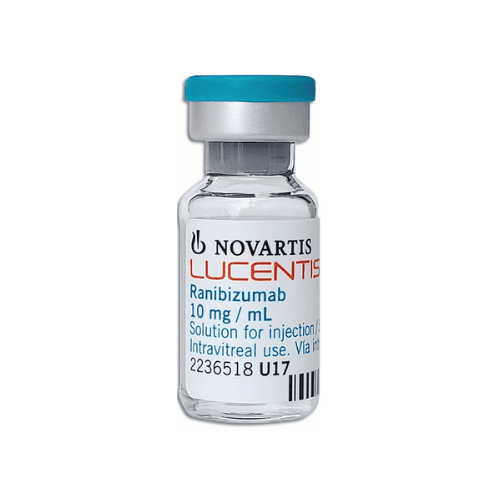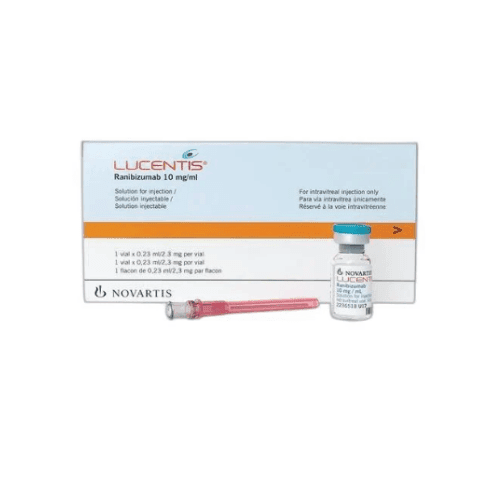Shipping with this method takes 3-5 days
Lucentis® Vial for Wet Age-Related Macular Degeneration
$2,414.99
Secure Encrypted Payments
Lucentis is a prescription anti-VEGF medicine used inside the eye. It helps treat several retinal conditions that can lead to vision loss. This page explains uses, dosing basics, storage, safety, and how to access the treatment.
What Lucentis Is and How It Works
YouDrugstore is a licensed Canadian pharmacy in Manitoba. Pharmacists review prescriptions before dispensing. Lucentis® contains ranibizumab, a VEGF-A inhibitor for intravitreal injection. It blocks abnormal blood vessel growth and leakage in the retina. That mechanism helps stabilize or improve vision in eligible patients. We provide US delivery from Canada, and this guide also helps if you are paying without insurance.
Lucentis Vial is supplied as a single-use, preservative-free vial for use by an eye care specialist. The medicine is drawn into a sterile syringe and injected into the vitreous cavity under aseptic technique. It is not a self-administered product. Your ophthalmologist determines if this therapy is appropriate for your condition.
Learn more about the conditions it treats on our pages for Wet Age Related Macular Degeneration, Diabetic Macular Edema, and Retinal Vein Occlusion. For general eye wellness content, see Healthy Vision Month and Cataract Awareness Month.
Who It’s For
This therapy is indicated for adults with neovascular (wet) age-related macular degeneration, macular edema after retinal vein occlusion, diabetic macular edema, diabetic retinopathy, and myopic choroidal neovascularization. It may not be suitable if you have active ocular or periocular infection, significant intraocular inflammation, or known hypersensitivity to ranibizumab or its components. Your prescriber will assess your medical history, eye exam, and imaging before recommending treatment.
Dosage and Usage
Intravitreal injections are performed by a retina specialist or trained ophthalmologist. Typical label-guided schedules involve once-monthly dosing at the strength appropriate for the specific condition. Some indications may allow individualized intervals after initial monthly doses, based on clinical evaluation, visual acuity, and imaging. If you are unsure of your schedule, defer to the official prescribing information and your clinician’s plan.
Before the procedure, the eye area is cleaned, and anesthetic and antiseptic are applied. The injection itself is brief. You will receive post-injection instructions, including when to call if you notice concerning symptoms. Clinic staff will plan follow-up visits to monitor your response and determine ongoing intervals.
Strengths and Forms
The product is supplied as a single-use vial intended for one eye only. Commonly published presentations include:
- 0.5 mg/0.05 mL vial for certain adult retinal conditions
- 0.3 mg/0.05 mL vial for diabetic eye disease indications
Labels and packaging may vary by market. Availability can change; your prescriber will specify the appropriate presentation. For reference, many clinics use a ranibizumab vial 0.5 mg in conditions such as wet AMD or RVO when aligned to local labeling.
Missed Dose and Timing
If an appointment is delayed or missed, contact the clinic to reschedule as soon as possible. Do not attempt to self-inject or adjust timing on your own. Schedules are guided by examination findings and your prescriber’s judgment. Keeping regular visits helps maintain the intended effect of therapy.
Storage and Travel Basics
Clinics typically handle storage and preparation. If you are coordinating supply, follow the package insert and pharmacy guidance for refrigeration and handling until the vial is used. Protect the carton from light and keep it out of reach of children. Do not freeze. Transport the medicine in a way that preserves labeled conditions, and bring it directly to your appointment.
For personal travel, plan with your clinic and pharmacy in advance. Use insulated carriers if instructed, keep documentation with your name and prescription details, and avoid temperature extremes during transit. The vial is single-use; do not reuse any portion. Lucentis injection vial must be prepared and administered by qualified medical staff using aseptic technique.
Benefits
This anti-VEGF therapy targets the pathway that drives leakage and growth of abnormal retinal vessels. By limiting VEGF activity, the treatment can help reduce retinal swelling and fluid, support vision maintenance, and improve anatomical outcomes in many patients. Monthly office-based dosing allows close monitoring, and the single-use format supports sterile technique at each visit.
Side Effects and Safety
- Eye pain or discomfort
- Conjunctival hemorrhage
- Intraocular inflammation or floaters
- Transient rise in intraocular pressure
- Foreign body sensation or tearing
Serious but less common risks include endophthalmitis, retinal detachment or tear, traumatic cataract, and arterial thromboembolic events. Contact your clinic urgently if you experience severe eye pain, sudden vision changes, increased floaters, sensitivity to light, or worsening redness. The risk of intraocular inflammation or infection is minimized with strict aseptic technique and post-injection monitoring.
Drug Interactions and Cautions
Systemic drug interactions are not commonly emphasized for this intravitreal therapy. However, your clinician should know all medicines and supplements you use. Report any recent or planned ocular surgery, active eye infection, or history of stroke or transient ischemic attack. Use in pregnancy or breastfeeding should be carefully considered by your prescriber. Do not use contact lenses until your clinician advises it is appropriate after an injection.
What to Expect Over Time
Many patients require ongoing injections over months or longer, with schedules tailored to clinical response. Vision may stabilize before any improvement is noticed. Regular imaging helps guide whether intervals can be extended. Adherence to follow-up is important; skipping visits can allow fluid to return. If you have questions about the plan, ask your eye care team to review goals and next steps at each visit.
Compare With Alternatives
Your prescriber may discuss other anti-VEGF options. Two commonly used alternatives include Eylea® and Beovu® Pre Filled Syringe. Selection depends on diagnosis, exam findings, medical history, and prior response. Decisions should follow the official labels and your clinician’s judgment.
Pricing and Access
We offer transparent Canadian pricing for branded ranibizumab. See our product page for current options, and compare choices with your clinic if they coordinate supply. For savings guidance, you can review insurance benefits or self-pay options before your next visit. Ships from Canada to US with pharmacy-handled logistics. If you watch for deals, visit our Promotions page for current offers. To review costs specifically, check our page for Lucentis vial price and ask your clinic about any administration fees billed separately.
Ranibizumab vial price can vary by market and availability. Your total out-of-pocket may include physician services and facility fees, which are set by your provider. We support encrypted checkout and standard documentation for clinic receiving.
Availability and Substitutions
Stock status can change. If a particular presentation is unavailable, your prescriber may recommend an approved alternative from the same class. The clinic will confirm whether a vial presentation or a prefilled syringe is appropriate for your situation, and whether a switch is clinically suitable.
Patient Suitability and Cost-Saving Tips
Good candidates are adults diagnosed with one of the labeled retinal conditions who can attend regular follow-up. Those with active ocular infection or significant intraocular inflammation should not receive an injection until cleared by a clinician. To manage costs, consider coordinating multi-visit planning with your clinic, setting refill reminders, and comparing billing arrangements for clinic-supplied medicine versus pharmacy-supplied options. When discussing ranibizumab vial price with your care team, ask which entity bills your insurance for the medicine and which bills for the procedure.
Questions to Ask Your Clinician
- Is this therapy the right choice for my specific diagnosis?
- What dosing interval do you plan for my first few months?
- How will you decide whether to extend or reduce visits?
- What symptoms after injection mean I should call right away?
- Could a prefilled syringe be appropriate instead of a vial?
- How will my insurance handle the medicine and the procedure?
Authoritative Sources
US Prescribing Information (FDA)
Health Canada Product Monograph
Manufacturer Information (Genentech)
Ready to get started? Submit your prescription and we will coordinate prompt, express, cold-chain shipping with your clinic or to your address where permitted. This information is educational and not a substitute for professional medical advice.
Express Shipping - from $25.00
Prices:
- Dry-Packed Products $25.00
- Cold-Packed Products $35.00
Shipping Countries:
- United States (all contiguous states**)
- Worldwide (excludes some countries***)
Standard Shipping - $15.00
Shipping with this method takes 5-10 days
Prices:
- Dry-Packed Products $15.00
- Not available for Cold-Packed products
Shipping Countries:
- United States (all contiguous states**)
- Worldwide (excludes some countries***)
What eye conditions does Lucentis treat?
Lucentis is an anti-VEGF medicine used to treat several retinal diseases in adults. Labeled uses include neovascular (wet) age-related macular degeneration, diabetic macular edema, diabetic retinopathy, macular edema following retinal vein occlusion, and myopic choroidal neovascularization. Your ophthalmologist confirms whether your diagnosis and exam findings match an approved indication. If another therapy in the same class is more appropriate, your prescriber will advise based on your history and response to prior treatment.
How often are injections needed?
Dosing intervals are set by your retina specialist using the official label as a guide. Many patients begin with monthly injections, then the schedule may remain monthly or be adjusted based on visual acuity, imaging, and overall response. Some conditions require ongoing treatment for a longer period. If you miss an appointment, call the clinic to reschedule. Do not attempt to self-administer or change the dosing schedule yourself.
What are the serious risks after an intravitreal injection?
Serious but uncommon risks include endophthalmitis, retinal detachment or tear, traumatic cataract, and sustained elevation of intraocular pressure. Symptoms that need urgent evaluation include severe eye pain, sudden vision loss or worsening, increasing floaters, sensitivity to light, and marked redness. Clinics use aseptic technique and provide instructions to reduce risks. If you experience any of these symptoms, contact your eye care team immediately or seek urgent care.
Can I drive after the injection visit?
Many patients can travel home after their appointment, but vision may be blurred temporarily due to dilating drops, anesthetic, or the procedure. Arrange transportation if your clinic recommends it or if you feel uncomfortable driving. Follow the post-injection guidance you receive. Wait until your vision feels clear and comfortable before driving or operating machinery. If you are unsure, ask your clinician at discharge.
How is the vial different from a prefilled syringe?
Both presentations contain the same active ingredient. A vial requires the clinic to prepare a sterile syringe from the single-use container. A prefilled syringe arrives ready for final preparation in the clinic. Your ophthalmologist will choose a presentation based on clinic workflow, supply availability, and your indication. Either way, injections are performed under aseptic technique by qualified eye care professionals.
How should the medicine be stored before my appointment?
If you are responsible for transporting the vial, follow the package insert and pharmacy instructions. Keep it in the original carton, protected from light, and out of children’s reach. Do not freeze the product. Use insulated transport as instructed, and bring it directly to your appointment so clinic staff can prepare it. Most clinics prefer to receive and store the product themselves to maintain chain-of-custody and labeled conditions.
Will insurance cover this treatment?
Coverage varies by plan and by whether the clinic supplies the medicine or you obtain it from a pharmacy. Ask your provider how the drug and procedure are billed. If paying out of pocket, request a detailed estimate that separates medicine, administration, and facility fees. Your pharmacist can also explain pharmacy costs and documentation needed by your clinic. We can work with your prescriber to ensure proper paperwork for verification.

